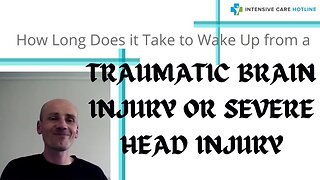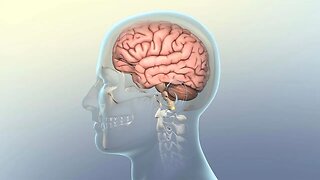Head Trauma 🧠 (Quick Medical Overview) | Traumatic Brain Injury
What is Head Trauma? What is a Traumatic Brain Injury? Watch this video to learn the medical definition of this topic!
💥Head Trauma [Full Guide] ➜ ➜ ➜ https://bit.ly/2MF62VJ
➡️ What is a Traumatic Brain Injury?
It's a general term that refers to an injury or trauma to the head that causes a disruption in normal brain function. Symptoms can be mild, moderate, or severe. For example, a concussion is usually considered to be a mild Traumatic Brain Injury.
➡️ Causes of a Traumatic Brain Injury:
▪ Motor vehicle accidents
▪ Falls
▪ Sports injuries
▪ Blunt force trauma
▪ Child abuse
▪ Blast injuries from explosions
▪ Being hit by a bullet or shrapnel
Keep in mind that there are many other causes of a Traumatic Brain Injury. These are just a few of the most common examples.
➡️ Signs and Symptoms of a Traumatic Brain Injury:
▪ Headache, lightheadedness, or dizziness
▪ Blurred vision
▪ Ringing ears
▪ Increased confusion, restlessness, or agitation
▪ Fatigue
▪ Loss of coordination
▪ Irregular breathing
▪ Irregular sleep patterns
▪ Lack of memory and concentration
▪ Vomiting or nausea
▪ Convulsions or seizures
▪ Difficulty waking up from sleep
▪ Slurred speech
▪ Abnormal pupillary response
▪ An altered level of consciousness
Again, a patient may experience other signs and symptoms with a Traumatic Brain Injury. These are just a few of the most common examples that you may see. And the severity of each symptom may vary from patient to patient. It really just depends on the severity of the injury that has occurred.
➡️ Head Trauma Considerations for Respiratory Therapists:
As a Respiratory Therapist, it’s important to monitor the patient's Intracranial Pressure (ICP) levels. This is especially true if the patient is receiving support via mechanical ventilation. You may be required to use minimal levels of PEEP in order to avoid an increased ICP. If head trauma has occurred, you may notice irregular breathing patterns. Particularly, the patient may show signs of Cheyne-stokes breathing which is an abnormal breathing pattern with periods of progressively deeper breaths alternating with periods of shallow breathing and apnea.
💥Head Trauma [Full Guide] ➜ ➜ ➜ https://bit.ly/2MF62VJ
—————
📗 BEST STUDY GUIDES FOR YOU
▪ TMC Test Bank 👉 http://bit.ly/2IGeqSu
▪ Hacking the TMC Exam 👉 http://bit.ly/2XBc8do
▪ TMC Exam Bundle (Save $) 👉 https://bit.ly/34pqEsV
▪ Daily TMC Practice Questions 👉 http://bit.ly/2NnXh3C
💙MORE FROM RTZ
▪ Free TMC Practice Exam 👉 http://bit.ly/2XlwASL
▪ Free RRT Cheat Sheet 👉 http://bit.ly/2IbmOKB
▪ Resources for RT's 👉 http://bit.ly/2WVV5qo
▪ Testimonials 👉 http://bit.ly/2x7b5Gl
🌐FOLLOW US
▪ Instagram 👉 http://bit.ly/2FhF0jV
▪ Twitter 👉 http://bit.ly/2ZsS6T1
▪ Facebook 👉 http://bit.ly/2MSEejt
▪ Pinterest 👉 http://bit.ly/2ZwVLPw
🚑MEDICAL DISCLAIMER
Medicine and Respiratory Therapy are continuously changing practices. The information in this video is for educational and entertainment purposes only. For medical advice, please consult with a physician or qualified medical professional.
💡AFFILIATE DISCLAIMER
This description contains affiliate links. If you decide to purchase a product through one of them, we receive a small commission at no cost to you.
—————
⏰TIMESTAMPS
0:00 - Intro
0:09 - What is a Traumatic Brain Injury?
0:25 - Causes of a Traumatic Brain Injury
0:48 - Signs and Symptoms of a Traumatic Brain Injury
2:08 - Head Trauma Considerations for Respiratory Therapists
—————
🖼CREDIT FOR MUSIC AND GRAPHICS:
▪ Music provided by https://audiojungle.net/
▪ Graphics: www.canva.com
▪ Graphics: www.freevector.com
▪ Graphics: www.vecteezy.com
▪ Graphics: www.pngtree.com
#HeadTrauma #RespiratoryTherapist #TraumaticBrainInjury
-
 7:39
7:39
Intensive Care Hotline
2 months agoHow Long Does It Take to Wake Up from a Traumatic Brain Injury or Severe Head Injury?
341 -
 21:34
21:34
Intensive Care Hotline
6 months agoWhat’s the Average Length of Stay in Intensive Care After Severe Head or Brain Trauma (TBI)?
37 -
 3:34
3:34
Nucleus Medical Media
8 months agoWhat is a Concussion and How Does it Affect The Brain?
29 -
 7:59
7:59
Intensive Care Hotline
2 months agoHow Long Will My Critically Ill Loved One in an Induced Coma for After a Brain or Head Injury?
91 -
 36:30
36:30
Intensive Care Hotline
1 year agoHow long does it take to wake up after head and brain injuries in intensive care?
2 -
 32:25
32:25
THEDRSGUIDE
4 months agoConcussion Recovery Secrets: How Vision Holds the Key, The Doctors Guide Ep 23 w Dr Bart Rademaker
8 -
 5:17
5:17
Dr. Eric Berg
5 years agoHead Injury and Concussion? Do This Acupressure for Head Trauma – Dr. Berg
17 -
 15:51
15:51
Intensive Care Hotline
4 months ago10 THINGS YOU DIDN’T KNOW ABOUT HEAD&BRAIN INJURIES YOU MUST KNOW WHEN UR LOVED ONE ISN’T WAKING UP
20 -
 13:23
13:23
Dr. Eric Berg
5 years agoHead Injuries, Acupressure & the Quality of Your Sleep – Dr. Berg
25 -
 0:42
0:42
Intensive Care Hotline
8 months agoQuick tip for families in ICU: Should my Dad have a tracheostomy after a Traumatic brain injury?
33